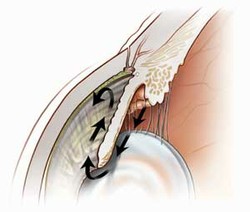Glaucoma is a common condition caused by the increase of pressure in the eye. If left untreated, severe damage can occur to the eye resulting in the loss of vision. As one of the common causes of blindness, it’s important for patients to take the health of the eye seriously to avoid this outcome.

Guide To Primary Open Angle Glaucoma
by CRfan
Primary open angle glaucoma is one of the most common causes for a permanent loss of vision.
Two Common Types of Glaucoma
There are two main types of glaucoma; primary open angle glaucoma and primary angle closure glaucoma. Open angle glaucoma can be treated with glaucoma drops to reduce the pressure and the instance of damage. Angle closure glaucoma can also be treated with drops temporarily but surgical intervention is needed.
The Development of Glaucoma
There is a constant flow of fluid throughout the eye. To help create and maintain the shape of the eye, the flow of fluid must be carefully maintained as too little fluid can cause the eye to become hard and too much fluid can cause the shape of the eye to become too soft. This fluid, the aqueous humor is released from the eye, near the iris, through tiny channels that create a flow through the pupil area and drain away from the area through small channels.
Glaucoma occurs when the flow of this liquid becomes obstructed causing pressure to build up throughout the eye area.
The two types of glaucoma differ from one another in the time that the condition takes to develop; primary open angle glaucoma develops slowly and is caused by the blockage of the tiny channels that control the flow into the eye area.
Primary angle closure glaucoma develops quickly and is referred to as acute glaucoma when the liquid is unable to pass through the eye area.
Though there are other types of glaucoma that occur throughout the eye, these are the two most common forms of the condition that are seen in patients.
What Are The Symptoms of Glaucoma?
Patients suffering from primary open angle glaucoma will experience a gradual loss in their vision. Many people are under the impression that they are simply aging and this is the cause of the vision problems and therefore aren’t aware that they are actually suffering from glaucoma symptoms. The first thing that patients notice with this type of glaucoma is the changes in the peripheral vision (to the sides) and eventually the glaucoma begins to affect the central vision.
There is no pain associated with the disorder and patients are screened through their annual eye exams once the patient reaches the age of forty, when the condition is most likely to occur.
Treatment for the primary open angle glaucoma begins with drops and a referral to an ophthalmologist who will complete the diagnosis and develop the treatment plan.
It’s difficult to prevent the condition and therefore the initial screening tests that are completed with the routine eye examinations is essential. Vision loss can be prevented, as long as the patient seeks medical attention early in the stages of the condition. If untreated, it can lead to vision loss in the patient suffering from glaucoma.
Careful Management
Glaucoma is associated with a family history and therefore patients with a history of glaucoma in their family should be screened regularly. It’s important to determine whether the patient is suffering from the condition early in the stages, to reduce the instance of vision loss.
Managing the condition can be effective through the use of observation and eye drops that are placed in the eye. Regular appointments can help to manage glaucoma without causing further damage.
You might also like
How to React to and Help a Loved One with CancerDealing with cancer? Learn how to react, treat and care for a loved one when ...
Do You Have Your Own Cure For Cancer?Is it possible you might be completely unaware of the cancer cure, a natural ...



 How The FDA Approves New Medicineson 08/16/2013
How The FDA Approves New Medicineson 08/16/2013
 10 Tax Mistakes Business Owners Makeon 08/05/2013
10 Tax Mistakes Business Owners Makeon 08/05/2013
 Accessories For Traveling With Jeweleryon 02/12/2013
Accessories For Traveling With Jeweleryon 02/12/2013
 Stages of the Sleep Cycleon 09/23/2012
Stages of the Sleep Cycleon 09/23/2012


Comments